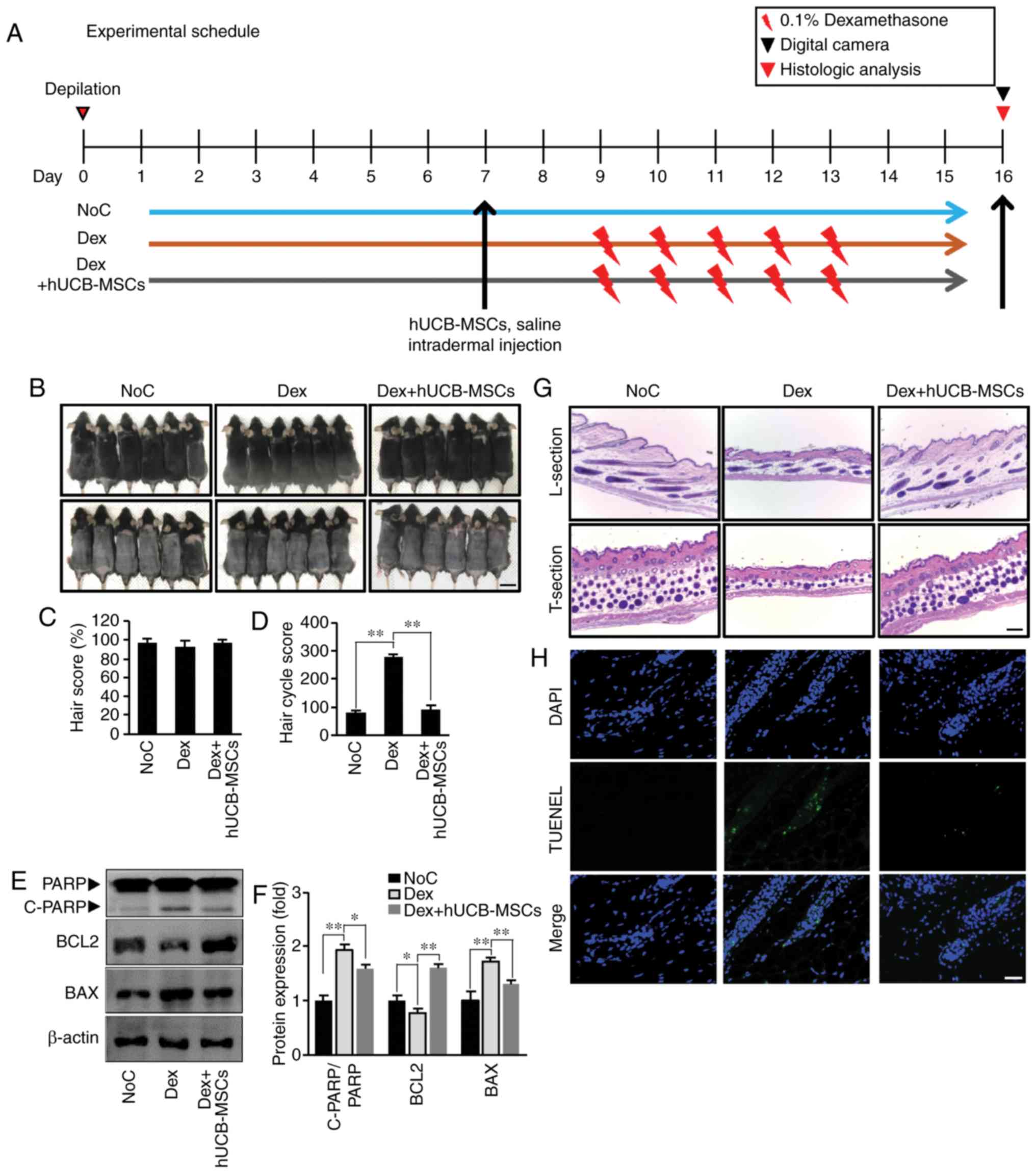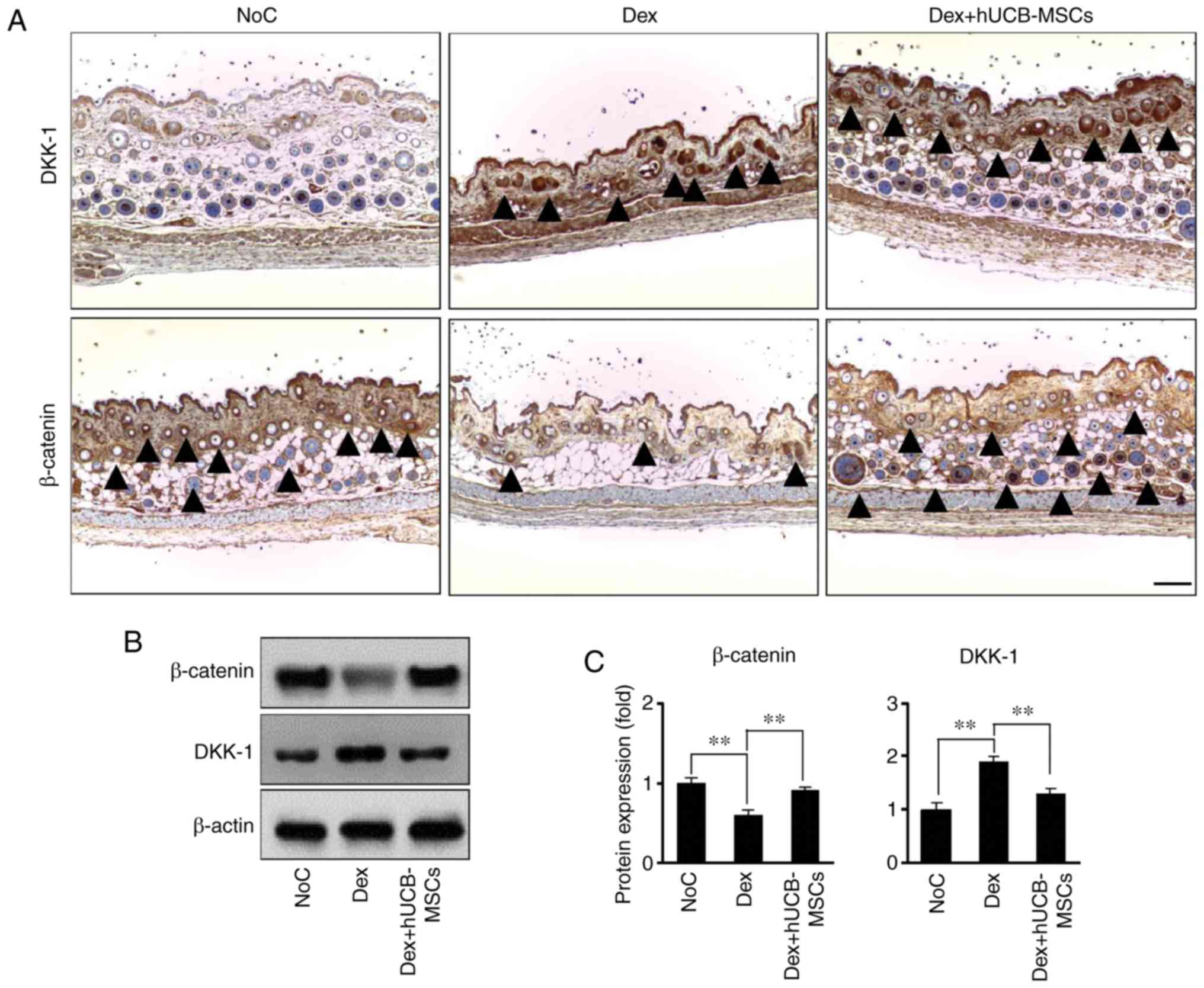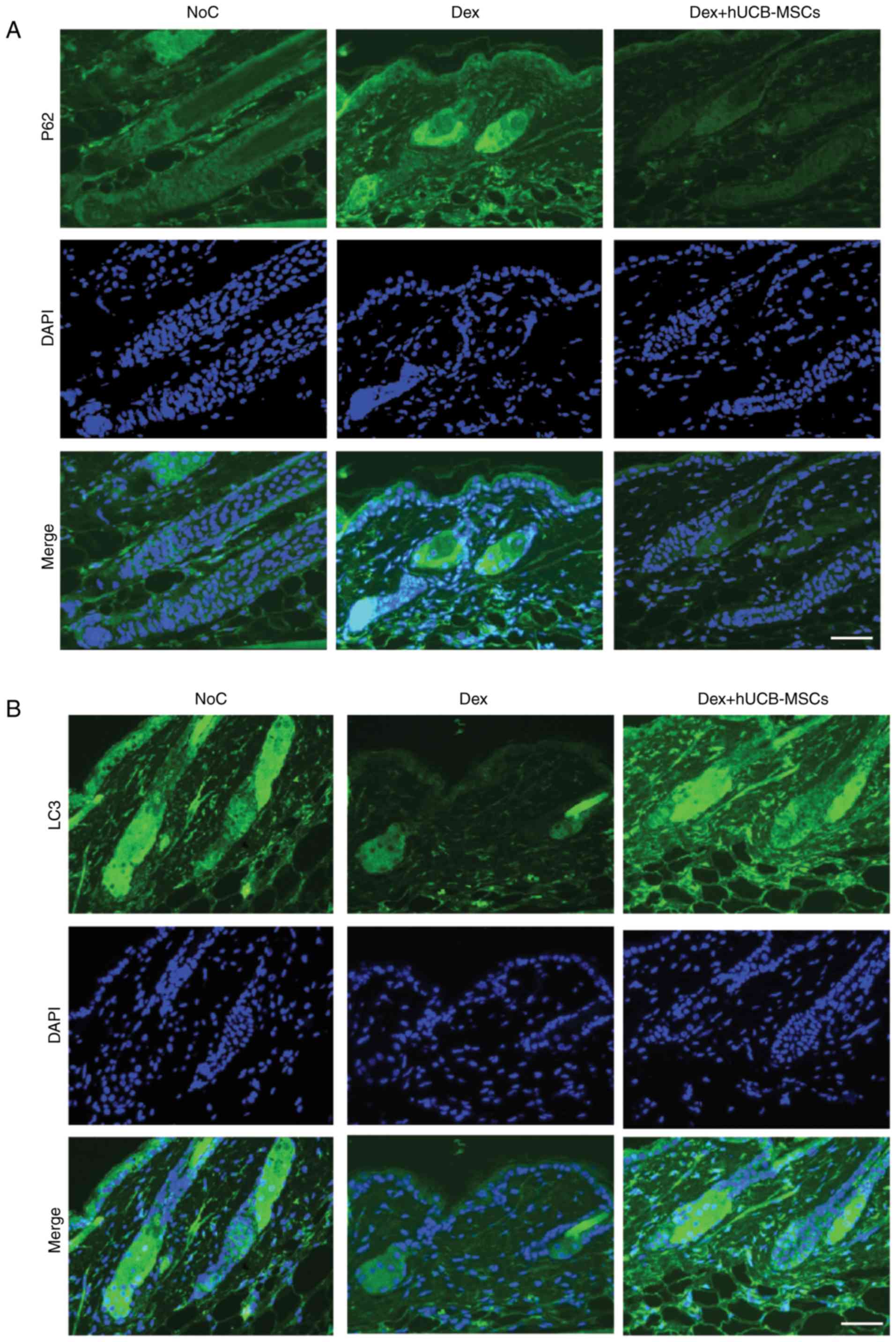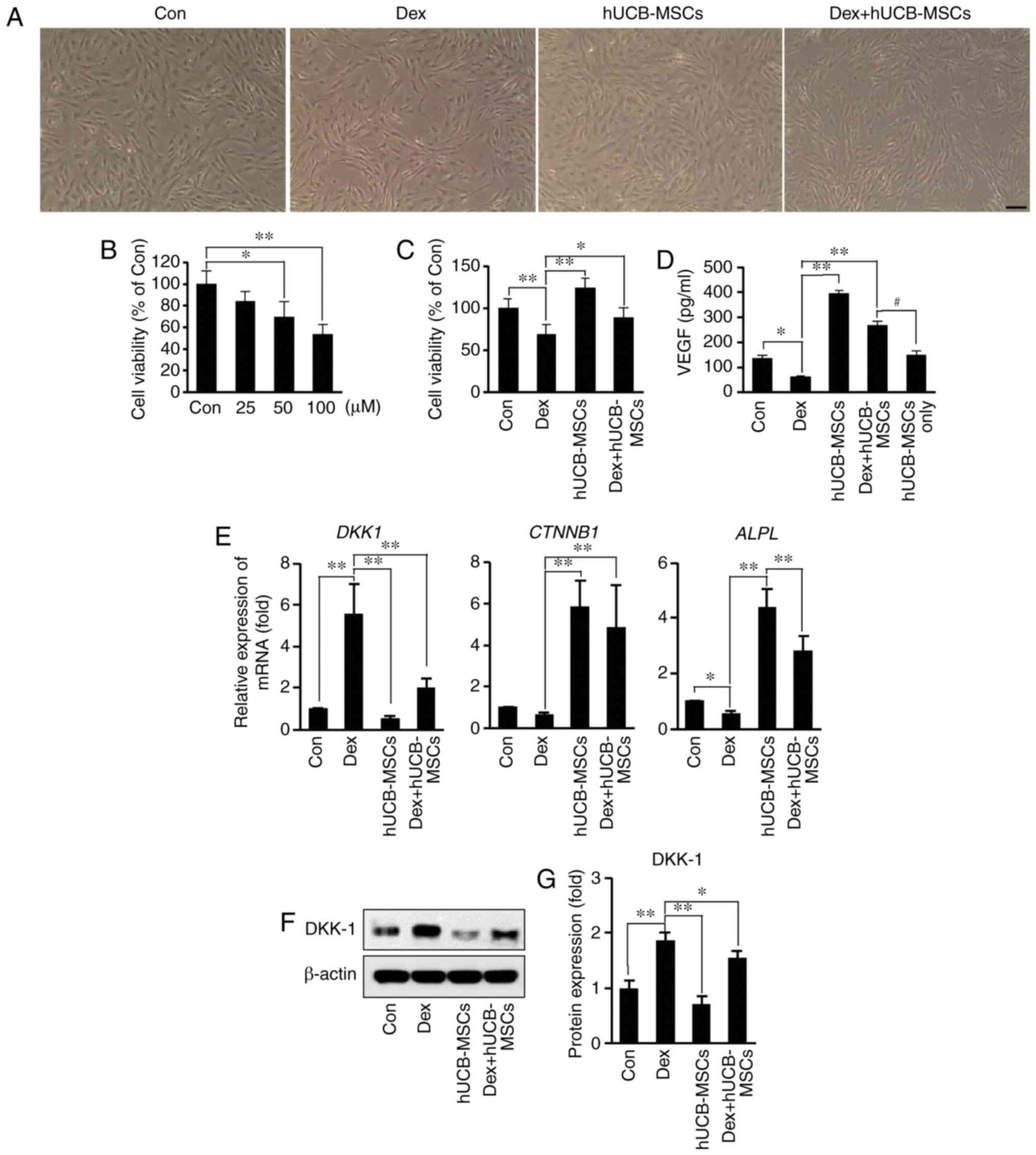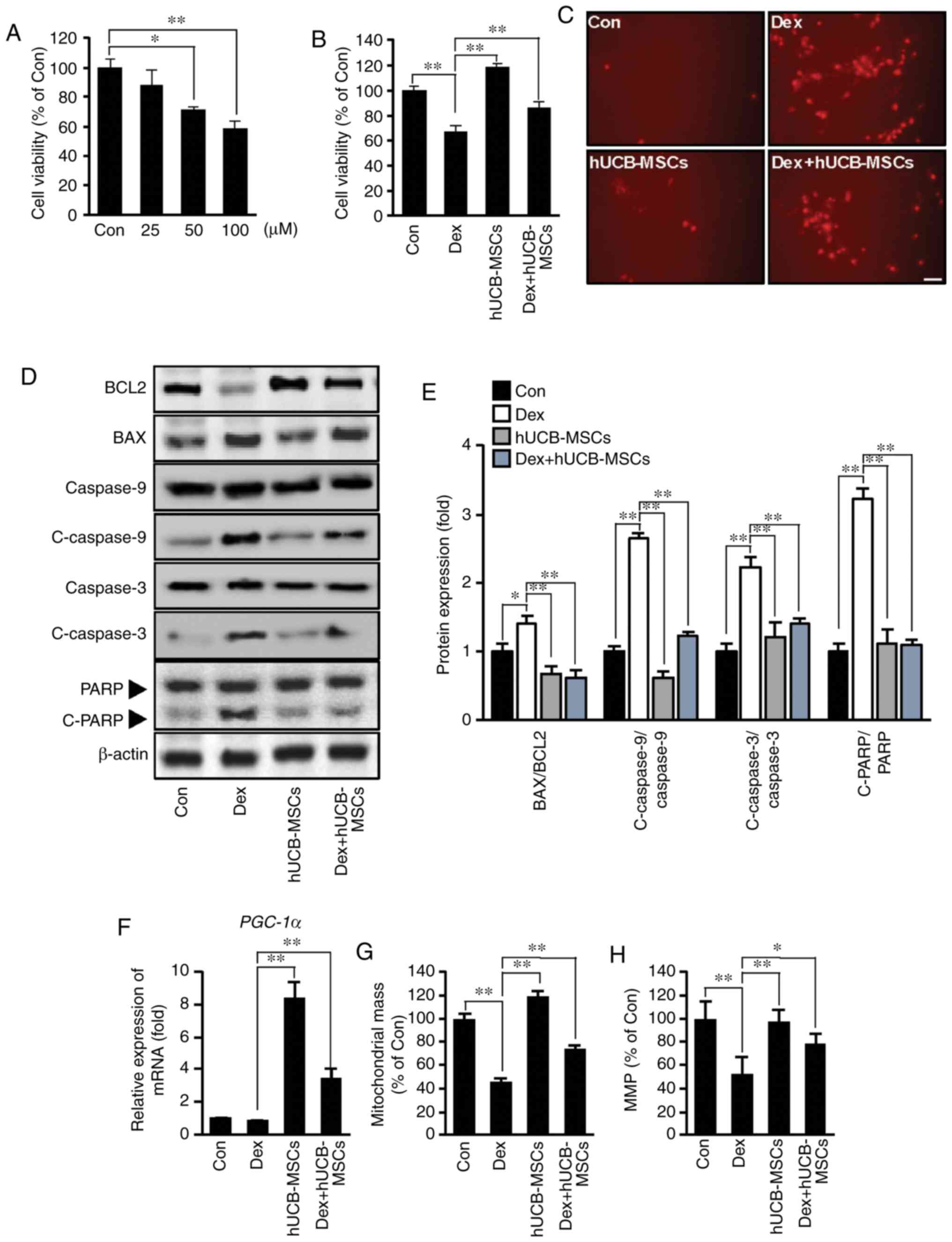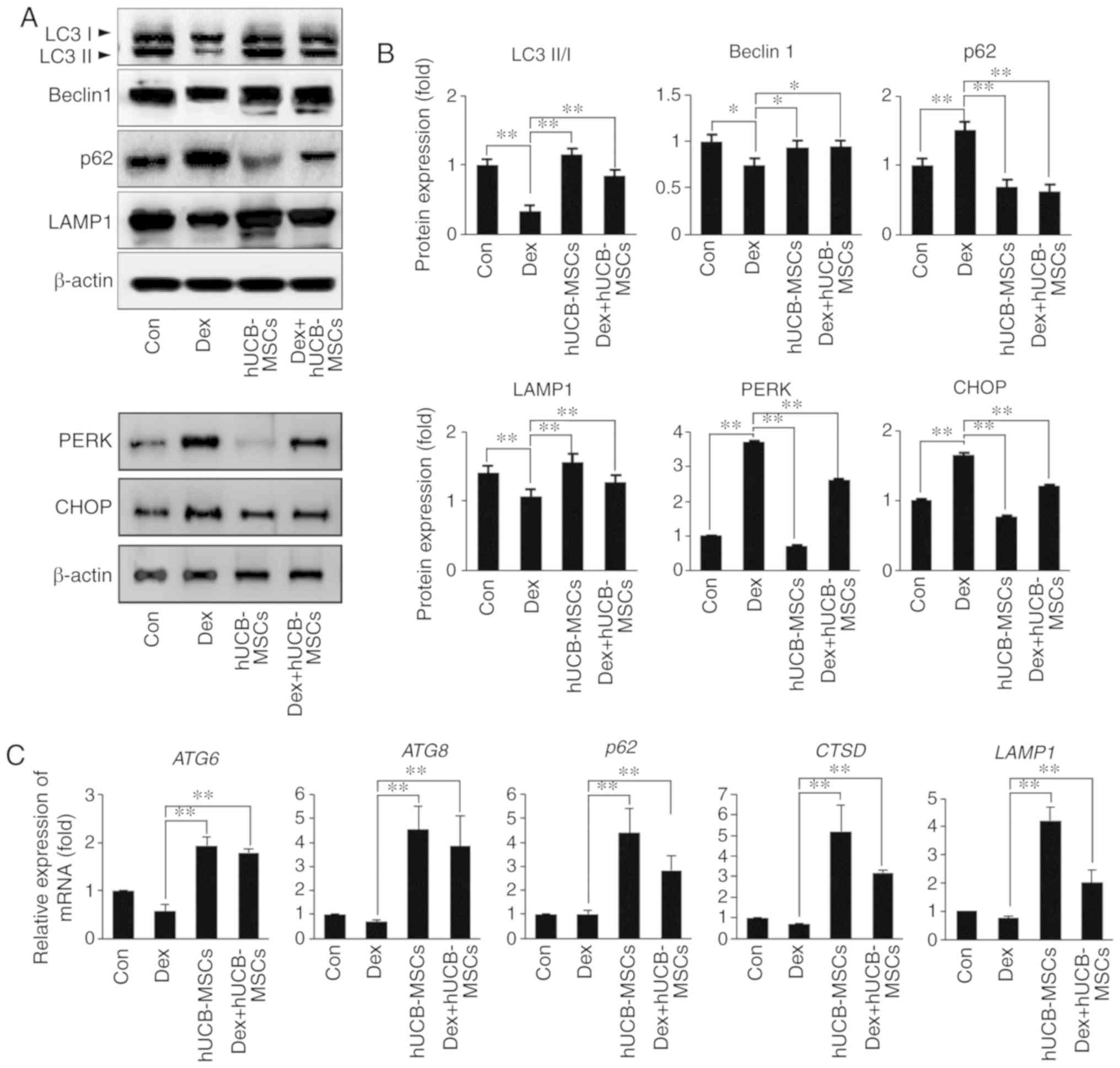|
1
|
Ding DC, Chang YH, Shyu WC and Lin SZ:
Human umbilical cord mesenchymal stem cells: A new era for stem
cell therapy. Cell Transplant. 24:339–347. 2015. View Article : Google Scholar : PubMed/NCBI
|
|
2
|
Oh W, Kim DS, Yang YS and Lee JK:
Immunological properties of umbilical cord blood-derived
mesenchymal stromal cells. Cell Immunol. 251:116–123. 2008.
View Article : Google Scholar : PubMed/NCBI
|
|
3
|
Chen M, Xiang Z and Cai J: The
anti-apoptotic and neuro-protective effects of human umbilical cord
blood mesenchymal stem cells (hUCB-MSCs) on acute optic nerve
injury is transient. Brain Res. 1532:63–75. 2013. View Article : Google Scholar : PubMed/NCBI
|
|
4
|
Kang SG, Jeun SS, Lim JY, Kim SM, Yang YS,
Oh WI, Huh PW and Park CK: Cytotoxicity of human umbilical cord
blood-derived mesenchymal stem cells against human malignant glioma
cells. Child's Nerv Syst. 24:293–302. 2008. View Article : Google Scholar
|
|
5
|
Lim JY, Jeong CH, Jun JA, Kim SM, Ryu CH,
Hou Y, Oh W, Chang JW and Jeun SS: Therapeutic effects of human
umbilical cord blood-derived mesenchymal stem cells after
intrathecal administration by lumbar puncture in a rat model of
cerebral ischemia. Stem Cell Res Ther. 2:382011. View Article : Google Scholar : PubMed/NCBI
|
|
6
|
Kim JY, Jeon HB, Yang YS, Oh W and Chang
JW: Application of human umbilical cord blood-derived mesenchymal
stem cells in disease models. World J Stem Cells. 2:34–38. 2010.
View Article : Google Scholar
|
|
7
|
Chung JY, Song M, Ha CW, Kim JA, Lee CH
and Park YB: Comparison of articular cartilage repair with
different hydrogel-human umbilical cord blood-derived mesenchymal
stem cell composites in a rat model. Stem Cell Res Ther. 5:392014.
View Article : Google Scholar : PubMed/NCBI
|
|
8
|
Hillmer AM, Hanneken S, Ritzmann S, Becker
T, Freudenberg J, Brockschmidt FF, Flaquer A, Freudenberg-Hua Y,
Jamra RA, Metzen C, et al: Genetic variation in the human androgen
receptor gene is the major determinant of common early-onset
androgenetic alopecia. Am J Hum Genet. 77:140–148. 2005. View Article : Google Scholar : PubMed/NCBI
|
|
9
|
Lindner G, Botchkarev VA, Botchkareva NV,
Ling G, van der Veen C and Paus R: Analysis of apoptosis during
hair follicle regression (catagen). Am J Pathol.
151:16011997.PubMed/NCBI
|
|
10
|
Courtois M, Loussouarn G, Hourseau C and
Grollier JF: Hair cycle and alopecia. Skin Pharmacol. 7:84–89.
1994. View Article : Google Scholar : PubMed/NCBI
|
|
11
|
Silverman MN and Sternberg EM:
Glucocorticoid regulation of inflammation and its functional
correlates: From HPA axis to glucocorticoid receptor dysfunction.
Ann N Y Acad Sci. 1261:55–63. 2012. View Article : Google Scholar : PubMed/NCBI
|
|
12
|
Pérez P: Glucocorticoid receptors,
epidermal homeostasis and hair follicle differentiation.
Dermatoendocrinol. 3:166–174. 2011. View Article : Google Scholar : PubMed/NCBI
|
|
13
|
Slominski A, Wortsman J, Tuckey RC and
Paus R: Differential expression of HPA axis homolog in the skin.
Mol Cell Endocrinol. 265:143–149. 2007. View Article : Google Scholar : PubMed/NCBI
|
|
14
|
Zhang X, Yu M, Yu W, Weinberg J, Shapiro J
and McElwee KJ: Development of alopecia areata is associated with
higher central and peripheral hypothalamic-pituitary-adrenal tone
in the skin graft induced C3H/HeJ mouse model. J Invest Dermatol.
129:1527–1538. 2009. View Article : Google Scholar
|
|
15
|
Ito N, Ito T, Kromminga A, Bettermann A,
Takigawa M, Kees F, Straub RH and Paus R: Human hair follicles
display a functional equivalent of the
hypothalamic-pituitary-adrenal axis and synthesize cortisol. FASEB
J. 19:1332–1334. 2005. View Article : Google Scholar : PubMed/NCBI
|
|
16
|
Arck PC, Handjiski B, Hagen E, Joachim R,
Klapp BF and Paus R: Indications for a 'brain-hair follicle axis
(BHA)': Inhibition of keratinocyte proliferation and up-regulation
of keratinocyte apoptosis in telogen hair follicles by stress and
substance P. FASEB J. 15:2536–2538. 2001. View Article : Google Scholar : PubMed/NCBI
|
|
17
|
Albus U: Guide for the Care and Use of
Laboratory Animals. 8th edition. SAGE Publications; Sage UK,
London: 2012
|
|
18
|
Kwon TR, Kim JH, Hong JY, Seok J, Kim JM,
Bak DH, Choi MJ, Mun SK, Kim CW and Kim BJ: Irradiation with 310 nm
and 340 nm ultraviolet light-emitting-diodes can improve atopic
dermatitis-like skin lesions in NC/Nga mice. Photochem Photobiol
Sci. 17:1127–1135. 2018. View Article : Google Scholar : PubMed/NCBI
|
|
19
|
Crema A, Ledda M, Fioretti D, Lolli MG,
Sanchez M, Carico E, Marchese R, Rinaldi M and Lisi A: Combination
of cord blood-derived human hepatic progenitors and hepatogenic
factors strongly improves recovery after acute liver injury in mice
through modulation of the Wnt/β-catenin signaling. J Tissue Eng
Regen Med. 13:1031–1043. 2019.PubMed/NCBI
|
|
20
|
Park S, Erdogan S, Hwang D, Hwang S, Han
EH and Lim YH: Bee venom promotes hair growth in association with
inhibiting 5α-reductase expression. Biol Pharm Bull. 39:1060–1068.
2016. View Article : Google Scholar : PubMed/NCBI
|
|
21
|
Müller-Röver S, Handjiski B, van der Veen
C, Eichmüller S, Foitzik K, McKay IA, Stenn KS and Paus R: A
comprehensive guide for the accurate classification of murine hair
follicles in distinct hair cycle stages. J Invest Dermatol.
117:3–15. 2001. View Article : Google Scholar : PubMed/NCBI
|
|
22
|
Choi W, Kwon SJ, Jin HJ, Jeong SY, Choi
SJ, Oh W, Yang YS, Jeon HB and Jeon ES: Optimization of culture
conditions for rapid clinical-scale expansion of human umbilical
cord blood-derived mesenchymal stem cells. Clin Transl Med.
6:382017. View Article : Google Scholar : PubMed/NCBI
|
|
23
|
Livak KJ and Schmittgen TD: Analysis of
relative gene expression data using real-time quantitative PCR and
the 2(-Delta Delta C(T)) method. Methods. 25:402–408. 2001.
View Article : Google Scholar
|
|
24
|
Bjørkøy G, Lamark T, Brech A, Outzen H,
Perander M, Overvatn A, Stenmark H and Johansen T: P62/SQSTM1 forms
protein aggregates degraded by autophagy and has a protective
effect on huntingtin-induced cell death. J Cell Biol. 171:603–614.
2005. View Article : Google Scholar : PubMed/NCBI
|
|
25
|
Lippai M and Lőw P: The role of the
selective adaptor p62 and ubiquitin-like proteins in autophagy.
BioMed Res Int. 2014:8327042014. View Article : Google Scholar : PubMed/NCBI
|
|
26
|
Lachgar S, Charveron M, Gall Y and Bonafe
J: Minoxidil upregulates the expression of vascular endothelial
growth factor in human hair dermal papilla cells. Br J Dermatol.
138:407–411. 1998. View Article : Google Scholar : PubMed/NCBI
|
|
27
|
Ito M, Yang Z, Andl T, Cui C, Kim N,
Millar SE and Cotsarelis G: Wnt-dependent de novo hair follicle
regeneration in adult mouse skin after wounding. Nature.
447:316–320. 2007. View Article : Google Scholar : PubMed/NCBI
|
|
28
|
Chen Y and Yu L: Autophagic lysosome
reformation. Exp Cell Res. 319:142–146. 2013. View Article : Google Scholar
|
|
29
|
Young TH, Lee CY, Chiu HC, Hsu CJ and Lin
SJ: Self-assembly of dermal papilla cells into inductive spheroidal
microtissues on poly (ethylene-co-vinyl alcohol) membranes for hair
follicle regeneration. Biomaterials. 29:3521–3530. 2008. View Article : Google Scholar : PubMed/NCBI
|
|
30
|
Sennett R and Rendl M:
Mesenchymal-epithelial interactions during hair follicle
morphogenesis and cycling. Semi Cell Dev Biol. 23:917–927. 2012.
View Article : Google Scholar
|
|
31
|
Yoo BY, Shin YH, Yoon HH, Seo YK, Song KY
and Park JK: Application of mesenchymal stem cells derived from
bone marrow and umbilical cord in human hair multiplication. J
Dermatolol Sci. 60:74–83. 2010. View Article : Google Scholar
|
|
32
|
Kim Y, Jin HJ, Heo J, Ju H, Lee HY, Kim S,
Lee S, Lim J, Jeong SY, Kwon J, et al: Small hypoxia-primed
mesenchymal stem cells attenuate graft-versus-host disease.
Leukemia. 32:26722018. View Article : Google Scholar : PubMed/NCBI
|
|
33
|
Shin H, Ryu HH, Kwon O, Park BS and Jo SJ:
Clinical use of conditioned media of adipose tissue-derived stem
cells in female pattern hair loss: A retrospective case series
study. Int J Dermatol. 54:730–735. 2015. View Article : Google Scholar : PubMed/NCBI
|
|
34
|
Hocking AM and Gibran NS: Mesenchymal stem
cells: Paracrine signaling and differentiation during cutaneous
wound repair. Exp Cell Res. 316:2213–2219. 2010. View Article : Google Scholar : PubMed/NCBI
|
|
35
|
Lai RC, Arslan F, Lee MM, Sze NS, Choo A,
Chen TS, Salto-Tellez M, Timmers L, Lee CN, El Oakley RM, et al:
Exosome secreted by MSC reduces myocardial ischemia/reper-fusion
injury. Stem Cell Res. 4:214–222. 2010. View Article : Google Scholar : PubMed/NCBI
|
|
36
|
Paus R, Handjiski B, Czarnetzki BM and
Eichmüller S: A murine model for inducing and manipulating hair
follicle regression (catagen): Effects of dexamethasone and
cyclosporin A. J Invest Dermatol. 103:143–147. 1994. View Article : Google Scholar : PubMed/NCBI
|
|
37
|
Kwack MH, Lee JH, Seo CH, Kim JC, Kim MK
and Sung YK: Dickkopf-1 is involved in dexamethasone-mediated hair
follicle regression. Exp Dermatol. 26:952–954. 2017. View Article : Google Scholar : PubMed/NCBI
|
|
38
|
Premanand A and Rajkumari BR: Androgen
modulation of Wnt/β-catenin signaling in androgenetic alopecia.
Arch Dermatol Res. 310:1–9. 2018. View Article : Google Scholar
|
|
39
|
Kishimoto J, Burgeson RE and Morgan BA:
Wnt signaling maintains the hair-inducing activity of the dermal
papilla. Genes Dev. 14:1181–1185. 2000.PubMed/NCBI
|
|
40
|
Huelsken J, Vogel R, Erdmann B, Cotsarelis
G and Birchmeier W: β-Catenin controls hair follicle morphogenesis
and stem cell differentiation in the skin. Cell. 105:533–545. 2001.
View Article : Google Scholar : PubMed/NCBI
|
|
41
|
Iida M, Ihara S and Matsuzaki T: Hair
cycle-dependent changes of alkaline phosphatase activity in the
mesenchyme and epithelium in mouse vibrissal follicles. Dev Growth
Differ. 49:185–195. 2007. View Article : Google Scholar : PubMed/NCBI
|
|
42
|
Zhou L, Xu M, Yang Y, Yang K, Wickett RR,
Andl T, Millar SE and Zhang Y: Activation of β-catenin signaling in
CD133-positive dermal papilla cells drives postnatal hair growth.
Plos One. 11:e01604252016. View Article : Google Scholar
|
|
43
|
He J, Zhou J, Yang W, Zhou Q, Liang X,
Pang X, Li J, Pan F and Liang H: Dexamethasone affects cell
growth/apoptosis/chemo-sensitivity of colon cancer via
glucocorticoid receptor α/NF-κB. Oncotarget. 8:67670–67683.
2017.PubMed/NCBI
|
|
44
|
Boix J, Bigas J, Sevilla LM, Iacobone M,
Citton M, Torresan F, Caroccia B, Rossi GP and Pérez P: Primary
aldosteronism patients show skin alterations and abnormal
activation of glucocorticoid receptor in keratinocytes. Sci Rep.
7:158062017. View Article : Google Scholar : PubMed/NCBI
|
|
45
|
Deckers J, Bougarne N, Mylka V, Desmet S,
Luypaert A, Devos M, Tanghe G, Van Moorleghem J, Vanheerswynghels
M, De Cauwer L, et al: Co-Activation of glucocorticoid receptor and
peroxisome proliferator-activated receptor-γ in murine skin
prevents worsening of atopic march. J Invest Dermatol.
138:1360–1370. 2018. View Article : Google Scholar
|
|
46
|
Gauthier A, Fisch A, Seuwen K, Baumgarten
B, Ruffner H, Aebi A, Rausch M, Kiessling F, Bartneck M,
Weiskirchen R, et al: Glucocorticoid-loaded liposomes induce a
pro-resolution phenotype in human primary macrophages to support
chronic wound healing. Biomaterials. 178:481–495. 2018. View Article : Google Scholar : PubMed/NCBI
|
|
47
|
Vogt CJ and Schmid-Schönbein GW:
Microvascular endothelial cell death and rarefaction in the
glucocorticoid-induced hypertensive rat. Microcirculation.
8:129–139. 2001. View Article : Google Scholar : PubMed/NCBI
|
|
48
|
Llambi F and Green DR: Apoptosis and
oncogenesis: Give and take in the BCL-2 family. Curr Opin Genet
Dev. 21:12–20. 2011. View Article : Google Scholar : PubMed/NCBI
|
|
49
|
Czabotar PE, Lessene G, Strasser A and
Adams JM: Control of apoptosis by the BCL-2 protein family:
Implications for physiology and therapy. Nat Rev Mol Cell Biol.
15:492014. View Article : Google Scholar
|
|
50
|
Palikaras K, Lionaki E and Tavernarakis N:
Balancing mitochondrial biogenesis and mitophagy to maintain energy
metabolism homeostasis. Cell Death Differ. 22:1399–1401. 2015.
View Article : Google Scholar : PubMed/NCBI
|
|
51
|
Crotzer VL and Blum JS: Autophagy and
adaptive immunity. Immunology. 131:9–17. 2010.PubMed/NCBI
|
|
52
|
Levine B and Deretic V: Unveiling the
roles of autophagy in innate and adaptive immunity. Nat Rev
Immunol. 7:767–777. 2007. View Article : Google Scholar : PubMed/NCBI
|
|
53
|
Parodi C, Hardman JA, Allavena G, Marotta
R, Catelani T, Bertolini M, Paus R and Grimaldi B: Autophagy is
essential for maintaining the growth of a human (mini-) organ:
Evidence from scalp hair follicle organ culture. Plos Biol.
16:e20028642018. View Article : Google Scholar
|
|
54
|
Jiang P and Mizushima N: LC3-and p62-based
biochemical methods for the analysis of autophagy progression in
mammalian cells. Methods. 75:13–18. 2015. View Article : Google Scholar
|
|
55
|
Wurzer B, Zaffagnini G, Fracchiolla D,
Turco E, Abert C, Romanov J and Martens S: Oligomerization of p62
allows for selection of ubiquitinated cargo and isolation membrane
during selective autophagy. Elife. 4:e089412015. View Article : Google Scholar : PubMed/NCBI
|















